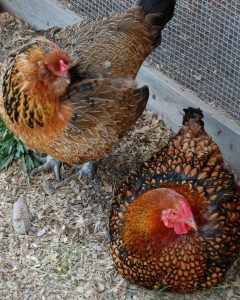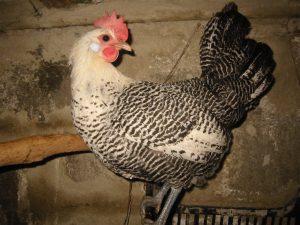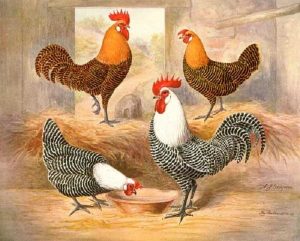 Overview
Overview
The Campine Chicken is an ancient breed available in both gold and silver coloration. The name reflects the area of Belgium / Holland where it was originally bred having been around for centuries. It has similar ancestry and appearance to the larger Brakael.
This breed is considered extremely rare and was first imported into the UK in the 19th century. The name is derived from the Campine country, where these fowls are bred largely for the production of white-shelled eggs. The English, or Standard Campine of today is a composite of two Belgian varieties with the plumage of the Campine male and female identical in color patterns.
Males on average weigh 6lbs (2.7kg) and females weigh 5lbs (2.3kg).
Eggs
Size
Medium size eggs
Color
White eggs
Production per year
200 eggs per annum
When do they start laying eggs?
From 20 weeks
Campine Characteristics
Temperament / Are they good as pets?
Very friendly and make great pets, especially good with children once tame. Good foragers and fliers so a fence is important or clipping the wings early so they cant fly.
How do I tame “Campine” chickens?
Feeding your chickens out of your hand is the best way to tame them, you can also pick them up when they’re young to tame them.
How many do I need to buy?
If you don’t have lots of space for a big free range flock you can get 2 at an absolute minimum. However, the more the merrier as we recommend a small flock of 6.
How much space do they need?
They’re very active birds and should be kept free range. To keep chickens free range you need at least 250 square feet per bird.
Will they mix with my other chickens?
They should mix with your other chickens, they are great foragers and so will be out socializing with other chickens.
Appearance
There are two different plumage colors which are gold and silver. The silver variety has a white neck and head whereas the gold variety has a golden head and neck. Their plumage is spotted with black feathers and they have a single comb.
The barring pattern in theses differs substantially to Rocks etc. as the bars have black lines three times the width of the white lines.
The males are hen feathered and their feathering made them the basis of much work on auto sexing breeds and work on gold / silver sex linkage.
Birds are to be barred in a transverse (V) section with gold or silver ends and well defined edge markings. Legs and feet lead coloured.
Very attractive looking chickens, that are mainly ornamental/show in north america despite the breed laying roughly 200 eggs a year. So considered a good layer and rarely go broody.


Feeding
What should I feed them?
When you first get your chicks they need to be fed growers mash as they need a smaller form of feed so that they an digest it easily.
Growers mash has 19{cfcd481556a8b43fba6af451761032bd323e94372a0c1e607} protein content and should be fed to your chicks until they are 6 weeks old. From then you can feed them chicken pellets, these have 15-16{cfcd481556a8b43fba6af451761032bd323e94372a0c1e607} protein content.
Once they are around 18 weeks you can gradually introduce layers mash or layers pellets to their feed. This has all the good stuff they need to help them produce eggs, it has around 16{cfcd481556a8b43fba6af451761032bd323e94372a0c1e607} protein.
How much should I feed them?
A chicken can eat anywhere between 2.9oz (80g) and 4.2oz (120g) a day, but on average they eat around ¼ of a pound (113g). Start with this amount and if you feel your chickens need more or less than this you can adjust accordingly.
Most people leave feed in their feeder for them to eat when they’re hungry but if you prefer you can feed them during mealtimes.
What can’t they eat?
Beans and chocolate are the two most harmful foods for chickens if ingested. Chocolate has theobromine and beans has phytohemagglutinin which once ingested make chickens very unwell and can cause fatalities.
Food which has ‘gone off’ and has gone moldy shouldn’t be given to chickens as they can contain bad bacteria which can make them sick.
For similar reasons, in the UK it is actually illegal to feed scraps or leftovers to your chickens.
What do I need to keep chickens?
You need a coop which has 1.1m2 or 11 square feet of space per chicken. The coop needs to have a perch for every one of you birds which they can rest on at night as well as some laying boxes which should be wooden and full of wood shavings.
As this breed prefers to be free range they should have at least 250 square feet of extra exercising space outside the coop per bird. This space needs to be somewhat shaded if you’re keeping these chickens for ornamental purposes as silver plumage can change color in direct sunlight.
Your coop needs a fence which is submerged at least 8 inches into the ground that goes over the top and around the whole coop to keep your chickens safe during the night once you have shut them in.
Water should be kept out of direct sunlight as chickens don’t like to drink warm water, the container should be one which they cannot stand in or tip over.
There should be grit always accessible for your chickens, especially once they start nearing laying age as grit is important to egg production.
